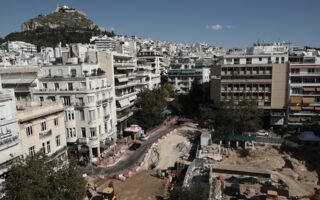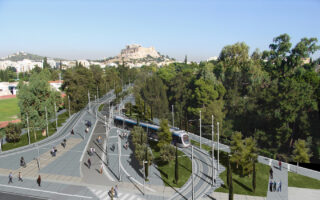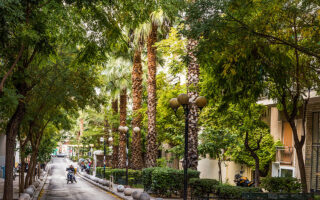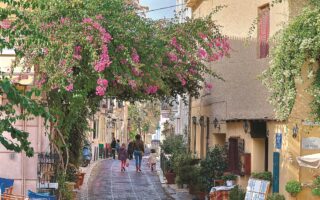Climate change: Saving Athens from itself
University of Toronto professor spearheads study for more greenery and water, fewer cars and reused buildings
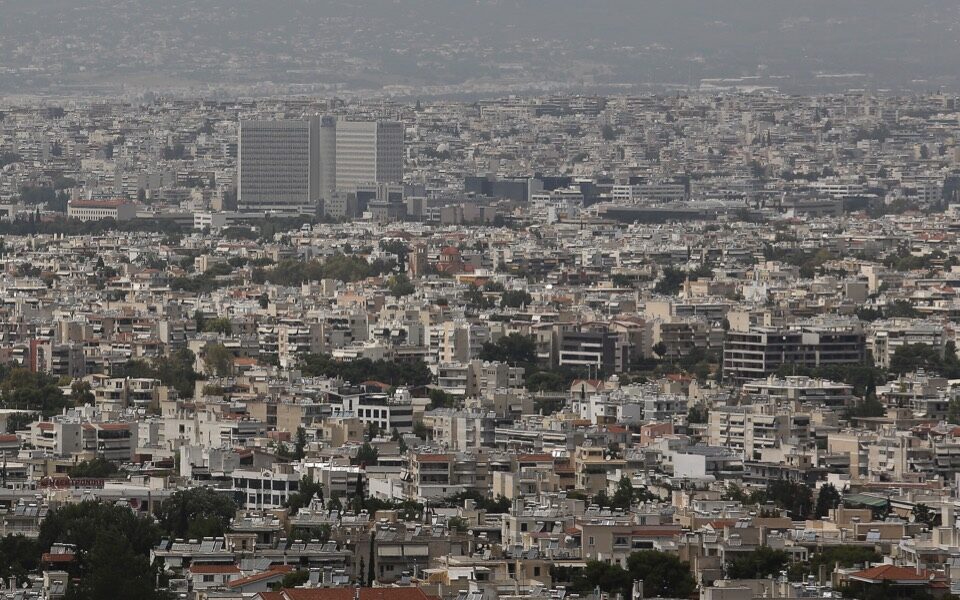
Public water reservoirs and drinking fountains, splash pads and fountains, pocket parks, green parking lots, trees and bushes in public spaces, sustainable mobility and reused buildings, starting with the public ones, are just some of the measures architect Petros Babasikas and his team recommend for Athens in the age of climate change.
As heatwaves – like the ones Greece has been experiencing this summer – become longer and more intense, modern cities need to develop new strategies and a practical toolkit to deal with the new challenges, Babasikas, head of the architecture program at the University of Toronto and of the Petros Babasikas Office, tells Kathimerini.
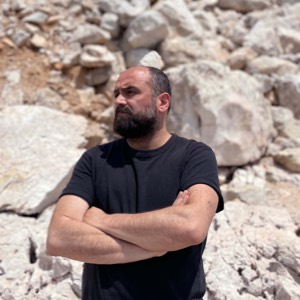 “The situation in Athens is similar to other big Mediterranean cities which developed residentially mainly between 1950 and 1980. Athens has a large heated mass, materials that absorb and store heat, such as reinforced concrete. Also a big problem is that we have covered the surfaces of the city with inert materials, with asphalt, with concrete. These lead to a rise in temperature,” Babasikas notes.
“The situation in Athens is similar to other big Mediterranean cities which developed residentially mainly between 1950 and 1980. Athens has a large heated mass, materials that absorb and store heat, such as reinforced concrete. Also a big problem is that we have covered the surfaces of the city with inert materials, with asphalt, with concrete. These lead to a rise in temperature,” Babasikas notes.
What can be done? “To begin with, we need to start looking differently at big projects that require a lot of resources and energy and leave a heavy footprint on the climate and the environment. We need big programs of small-scale, high-efficiency interventions. A combination of smart localized initiatives and model interventions with a few more comprehensive projects. What is needed here is architecture for the new age,” the Toronto University academic responds.
“Reuse is also crucial in this situation in Mediterranean cities, but also more generally. We’re talking about hundreds of thousands of buildings that need to be fully renovated from the ground up, upgraded and reused. This is the solution, not tearing them down and erecting new behemoths,” he adds.
What are some of his observations when it comes to Athens? “We create a park and then we abandon it. We leave cities without proper maintenance so they fall apart,” he says.
Water first
Another very important thing that needs to be secured is an adequate supply of water, says Babasikas, noting that thanks to huge infrastructure projects bringing water from a large part of central Greece, Athens has sufficiency. “The price, however, is that those areas are at risk in periods of drought, so we need to collect water in the city much more actively. Our team has come up with proposals for creating new local reservoirs, below and above ground, in order to store rainwater. We even recommend that underground parking garages should give up 30% of their area to accommodate water tanks.”
That water, he explains, can be used to irrigate parks and planters. Providing free drinking water is another idea.
“Athens used to have public drinking fountains and a few have been created today too, having a positive effect. We could create a network of fountains that provide free drinking water. This would also address the problem of single-use plastic,” adds the academic, referring to rife pollution from discarded plastic water bottles.
Splash pads and fountains are another way to keep the city and its people cooler, according to Babasikas’ team.
Stream beds
The academic laments the loss of the city’s rivers and streams. “Athens is one of the few cities that has hidden its rivers. The Ilisos, for example, is covered everywhere except for the stretch between Kallithea and Faliro. Important studies and research programs have been carried out on the benefits of opening it up from Agia Foteini to Kallirios, but it takes political will. Indeed, it would cause some changes to the circulation of traffic in the area, but the benefits to the public space and urban ecology would be significant,” adds Babasikas.
‘We should no longer be designing the city for cars, but taking initiatives to limit them’
Gardens, gardens everywhere is another motto. “Plant everywhere you can, make every public space green. Pocket parks, rainwater parks, parks in unbuilt land plots; low-cost vertical gardens with scaffolding and large containers. There are unbuilt plots of land in Athens that the state can borrow to make nursery gardens until the owners decide to build. Sometimes decades go by, so it would be a significant win. Also, outdoor parking lots could have 40% of their surface area covered in greenery, with tall trees and the ground could be designed with permeable surfaces of mixed materials. We could park under trees as we do at the beach. Incentives could also be given to residents in neighborhoods to tend to their local gardens,” he says.
Babasikas stresses that interventions must be planned so they are continuous, forming networks, as opposed to being fragmented; eco-friendly routes with greenery, water, paths for walking and lanes for cycling. Such networks allow air to flow and nature to flourish. “But we also need another development model,” he warns. “We should no longer be designing the city for cars, but taking initiatives to limit them. Bicycle lanes, for example, cannot be fragmented strips, but continuous lines that are protected from cars.”
Last but not least, a massive investment program is needed to reduce the energy consumption and increase the insulation of the Greek capital’s buildings.
Political will
Is all this feasible? Babasikas rests on two points. “First, it requires political will and the mobilization of citizens, who need to be fervent about these changes. It is also important for citizens themselves to reduce their energy footprint. Secondly, there needs to be a maintenance and sanitation plan, oversight of the projects by the state or local authorities, specific protocols that apply for years after the projects are built.”
Most of these proposals are included in Athens 2030, an interdisciplinary research program that was carried out by the University of Toronto in 2020-21 in response to the need for shielding the city from rising temperatures, urban abandonment and the touristification of the city center.
The study focused on the downtown district of Kerameikos and Kotzia and Klafthmonos squares, and examined the reuse of vacant public buildings, the introduction of rainwater storage systems, extensive planting of resilient trees and vertical gardens, as well as the development of public water networks.

